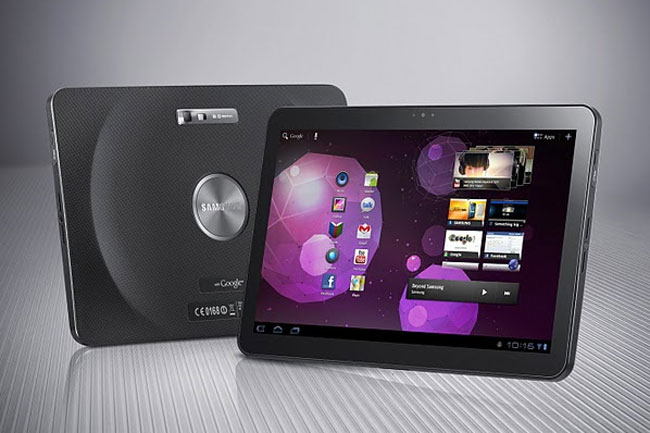Samsung Galaxy Tab 10.1: Review

Samsung’s Galaxy Tab 10.1 is a solid Android tablet effort. If it’s a sign of things to come, Apple has serious competition in the pipeline
It hasn’t been the best year for iPad rivals so far.
The Motorola Xoom sold 250,000 units in its first quarter of release, a solid number — until you compare it to the iPad, which managed to ship millions during the same frame. Research In Motion’s PlayBook tablet received lukewarm reviews, and proved something less than a blockbuster on store shelves. Meanwhile, J.P. Morgan analyst Mark Moskowitz suggested in a May research note that, in light of anemic sales numbers, manufacturers have begun reducing build plans for their respective tablet offerings.
Into this rough-and-tumble environment comes the Samsung Galaxy Tab 10.1. The successor to the original 7-inch Galaxy Tab, which debuted late in 2010 to solid reviews and sales, this 10.1-inch device (hence the name, presumably) comes with some significant firepower in the hardware department: a 1GHz dual-core Nvidia Tegra 2 processor, paired to a screen with 1280 by 800 resolution. It’s also slim, and light at 1.3 pounds.
A strong iPad competitor
The Tab 10.1 runs Google Android 3.1, a slight tweak above the tablet-optimised Android 3.0 “Honeycomb” build that debuted with the Motorola Xoom. The Android Market boasts a smallish-but-growing collection of tablet-ready applications, including some light productivity software and the ever-popular Angry Birds. Google’s music service (still in beta) and Samsung’s emphasis on video playback aim to make the tablet a viable multimedia device.
 Samsung made the WiFi-only Tab available on 8 June exclusively at one Best Buy in New York City, with plans to expand that to other retailers and online, starting June 17. The 16GB version of the device retails for $499 (£309), and the 32GB version for $599 (£371).
Samsung made the WiFi-only Tab available on 8 June exclusively at one Best Buy in New York City, with plans to expand that to other retailers and online, starting June 17. The 16GB version of the device retails for $499 (£309), and the 32GB version for $599 (£371).
With all those details in place, how does the Tab 10.1 perform in battle?
For those in the market for a non-Apple tablet — whatever your reasons may be — the Tab 10.1 may fulfill all your needs. The user interface feels polished, with some nifty navigation tools (such as an expanding tray on the lower-left side of the screen that offers one-tap access to applications) and plus-sized widgets that nicely fill the tablet’s five home screens.
Your Google account is now capable of activating a nice range of baked-in services, from email to calendar to music, with new notifications popping up along the lower-right screen. The tablet’s thin and lightweight form-factor makes it easy to carry and hold — just about as easily as the iPad 2, which represents the benchmark in that regard.
The Tab’s 7,000-mAh battery seemed capable of delivering a full day’s worth of email, web cruising and game playing. During intense periods of activity, the casing warms only a little — in contrast to those mobile devices, which, in the midst of heavy use, threaten to heat to a thigh-boiling intensity.
The Tab 10.1 includes a 3-megapixel rear-facing camera paired with a 2-megapixel one in the front of the device. Both cameras are serviceable but unspectacular (not that anyone uses tablets to shoot award-winning photography in the first place). The screen’s 1280 by 800 resolution translates into ultra-crisp e-reading and video playback. (For the latter, you’ll need to download the latest Adobe Flash.)
Needs more apps, better compatibility
That being said, there are some quibbles. The Android Market feels far, far sparer on the tablet applications than Apple’s App Store, but presumably that will change in coming months. On a more problematic note, connecting your Tab 10.1 to a MacBook via USB will result in… absolutely nothing, even after you download and install the Android File Transfer application for Mac.
Hopefully, Samsung will push out an update that supports its new device sooner rather than later; in the meantime, the only way to transfer files from a Mac to a tablet is via Wi-Fi, which can prove problematic at moments. (Connecting your Tab 10.1 with a PC, on the other hand, is a straightforward experience.)
If you hate virtual keyboards, the one offered with Android 3.1 will do absolutely nothing to sway that opinion. The keys are widely spaced and responsive, although typing anything longer than an email will reveal that fundamental Achilles’ Heel of all tablets: No matter what anybody claims, these devices simply aren’t the ideal form factor for composing long documents.
Will the Tab 10.1 topple the iPad? Given Apple’s momentum in the tablet arena, that seems unlikely. However, if Samsung’s latest effort is indeed a harbinger of Android tablets to come, it could bode well for iPad competitors to come. There’s a lot in the Tab 10.1 to like; more to the point, unlike some Android devices to hit the market in the past, there aren’t many issues with the device that can’t be fixed with future updates.